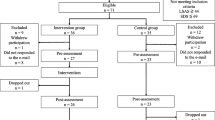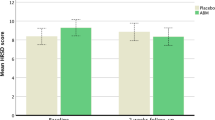Abstract
A growing body of research indicates that cognitive bias modification (CBM) may be an effective intervention for individuals with anxiety. However, few studies have tested whether CBM works for other disorders characterized by negative cognitive biases such as depression. This experiment tested the efficacy of CBM for altering depressogenic self-worth biases. Consistent with hypotheses, results showed that CBM was more effective than a control condition in teaching participants a more adaptive cognitive style (i.e., increased attention for adaptive self-worth stimuli). Those who successfully learned a more adaptive style reported fewer depressive symptoms and exhibited greater persistence (i.e., less helplessness) on a difficult laboratory task. However, the task proved difficult for cognitively vulnerable participants; they were not able to maintain their new learning over the entire course of the CBM training. Rather, their negative cognitive bias began to re-emerge after only 20 learning trials. These results indicate that CBM attention training might be most effective in reducing cognitive vulnerability when initially used in small doses.



Similar content being viewed by others
References
Abramson, L. Y., Alloy, L. B., Hankin, B. L., Haeffel, G. J., MacCoon, D. G., & Gibb, B. E. (2002). Cognitive vulnerability-stress models of depression in a self-regulatory and psychobiological context. In I. H. Gotlib & C. L. Hammen (Eds.), Handbook of depression. New York: Guilford.
Abramson, L. Y., Alloy, L. B., Hogan, M. E., Whitehouse, W. G., Donovan, P., Rose, D., et al. (1999). Cognitive vulnerability to depression: Theory and evidence. Journal of Cognitive Psychotherapy: An International Quarterly, 13, 5–20.
Abramson, L. Y., Metalsky, G. I., & Alloy, L. B. (1989). Hopelessness depression: A theory-based subtype of depression. Psychological Review, 96, 358–372.
Alloy, L. B., Abramson, L. Y., Hogan, M. E., Whitehouse, W. G., Rose, D. T., Robinson, M. S., et al. (2000). The Temple-Wisconsin cognitive vulnerability to depression project: Lifetime history of axis I psychopathology in individuals at high and low cognitive risk for depression. Journal of Abnormal Psychology, 109, 403–418.
Alloy, L. B., Abramson, L. Y., Whitehouse, W. G., Hogan, M. E., Panzarella, C., & Rose, D. T. (2006). Prospective incidence of first onsets and recurrences of depression in individuals at high and low cognitive risk for depression. Journal of Abnormal Psychology, 115, 145–156.
Amir, N., Beard, C., Burns, M., & Bomyea, J. (2009). Attention modification program in individuals with generalized anxiety disorder. Journal of Abnormal Psychology, 118, 28–33.
Baert, S., De Raedt, R., Schacht, R., & Koster, E. H. W. (2010). Attentional bias training in depression: Therapeutic effects depend on depression severity. Journal of Behavior Therapy and Experimental Psychiatry, 41, 265–274.
Beck, A. T. (1967). Depression: Clinical, experimental, and theoretical aspects. New York: Harper & Row.
Carroll, J. B., Davies, P., & Richman, B. (1971). Word frequency book. New York: American Publishing Co., Inc.
Carter, R. M., Hofstotter, C., Tsuchiya, N., & Koch, C. (2003). Working memory and fear conditioning. Proceedings of the National Academy of Science, 100, 1399–1404.
Clark, L. A., & Watson, D. (1991). Tripartite model of anxiety and depression: Psychometric evidence and taxonomic implications. Journal of Abnormal Psychology, 100, 316–336.
Diamond, A., & Kirkham, N. (2005). Not quite as grown-up as we like to think—parallels between cognition in childhood and adulthood. Psychological Science, 16, 291–297.
Erskine, J.A., Georgiou, G.J., & Kvavilashvili, L. (in press). I suppress, therefore I smoke: Effects of thought suppression on smoking behavior. Psychological Science.
Gibb, B. E., Beevers, C. G., Andover, M. S., & Holleran, K. (2006). The hopelessness theory of depression: A prospective multi-wave test of the vulnerability-stress hypothesis. Cognitive Therapy and Research, 30, 763–772.
Haeffel, G. J., Gibb, B. E., Abramson, L. Y., Alloy, L. B., Metalsky, G. I., Joiner, T., et al. (2008). Measuring cognitive vulnerability to depression: Development and validation of the cognitive style questionnaire. Clinical Psychology Review, 28, 824–836.
Haeffel, G. J., Abramson, L. Y., Brazy, P., Shah, J., Teachman, B., & Nosek, B. (2007). Explicit and implicit cognition: A preliminary test of a dual-process theory of cognitive vulnerability. Behaviour Research and Therapy, 45, 1155–1167.
Haeffel, G. J., & Mathew, A. R. (2010). Inside thoughts and outside influences: Cognitive vulnerability moderates the effect of decreases in perceived social support on depressive symptoms. Journal of Social and Clinical Psychology, 29, 283–302.
Hakamata, Y., Lissek, S., Bar-Haim, Y., Britton, J. C., Fox, N. A., Leibenluft, E., et al. (2010). Attention bias modification treatment: A meta-analysis toward the establishment of novel treatment for anxiety. Biological Psychiatry, 68, 982–990.
Hankin, B. L. (2005). Childhood maltreatment and psychopathology: Prospective tests of attachment, cognitive vulnerability, and stress as mediating processes. Cognitive Therapy and Research, 29, 645–671.
Hankin, B. L., Abramson, L. Y., Miller, N., & Haeffel, G. J. (2004). Cognitive vulnerability-stress theories of depression: Examining affective specificity in the prediction of depression versus anxiety in three prospective studies. Cognitive Therapy and Research, 28, 309–345.
Hankin, B. L., Abramson, L. Y., Moffitt, T. E., Silva, P., McGee, R., & Angell, K. E. (1998). Development of depression from preadolescence to young adulthood: Emerging gender differences in a 10-year longitudinal study. Journal of Abnormal Psychology, 107, 128–140.
Hollon, S. D., Thase, M. E., & Markowitz, J. C. (2002). Treatment and prevention of depression. Psychological Science in the Public Interest, 3, 39–77.
Holmes, E. A., Lang, T. J., & Shah, D. M. (2009). Developing interpretation bias modification as a “cognitive vaccine” for depressed mood: Imagining positive events makes you feel better than thinking about them verbally. Journal of Abnormal Psychology, 118, 76–88.
Joormann, J., & Gotlib, I. H. (2007). Selective attention to emotional faces following recovery from depression. Journal of Abnormal Psychology, 116, 80–85.
Joormann, J., Hertel, P. T., LeMoult, J., & Gotlib, I. H. (2009). Training forgetting of negative material in depression. Journal of Abnormal Psychology, 118, 34–43.
Jonides, J., Smith, E. E., Marshuetz, C., Koeppe, R. A., & Reuter-Lorenze, P. A. (1998). Inhibition in verbal working memory revealed by brain activation. Proceedings of the National Academy of Sciences, 95, 8410–8413.
Koster, E. H. W., Fox, E., & MacLeod, C. (2009). Introduction to the special section on cognitive bias modification in emotional disorders. Journal of Abnormal Psychology, 118, 1–4.
Li, S., Tan, J., Qian, M., & Liu, X. (2008). Continual training of attentional bias in social anxiety. Behaviour Research and Therapy, 46, 905–912.
Lyubomirsky, S., Tucker, K. L., Caldwell, N. D., & Berg, K. (1999). Why ruminators are poor problem solvers: clues from the phenomenology of dysphoric rumination. Journal of Personality and Social Psychology, 77, 1041–1060.
MacLeod, C., Mathews, A., & Tata, P. (1986). Attentional bias in emotional disorders. Journal of Abnormal Psychology, 95, 15–20.
MacLeod, C., Rutherford, E., Campbell, L., Ebsworthy, G., & Holker, L. (2002). Selective attention and emotional vulnerability: Assessing the causal basis of their association through the experimental manipulation of attentional bias. Journal of Abnormal Psychology, 111, 107–123.
McNeil, N. M., & Alibali, M. W. (2005). Why won’t you change your mind? Knowledge of operational patterns hinders learning and performance on equations. Child Development, 76, 883–899.
Metalsky, G. I., & Joiner, T. E. (1992). Vulnerability to depressive symptomatology: A prospective test of the diathesis-stress and causal mediation components of the hopelessness theory of depression. Journal of Personality and Social Psychology, 63, 667–675.
Mogg, K., Mathews, A., Bird, C., & MacGregor-Morris, R. (1990). Effects of stress and anxiety on the processing of threat stimuli. Journal of Personality and Social Psychology, 59, 1230–1237.
Muraven, M., & Baumeister, R. F. (2000). Self-regulation and depletion of limited resources: Does self-control resemble a muscle? Psychological Bulletin, 126, 247–259.
Nolen-Hoeksema, S. N., Wisco, B. E., & Lyubomirsky, S. (2008). Rethinking rumination. Perspectives on Psychological Science, 3, 400–423.
Ray, R. D., Ochsner, K. N., Cooper, J. C., Robertson, E. R., Gabrieli, J. D. E., & Gross, J. J. (2005). Individual differences in trait rumination and the neural systems supporting cognitive reappraisal. Cognitive, Affective & Behavioral Neuroscience, 5, 156–168.
Reber, P. J., & Kotovsky, K. (1997). Implicit learning in problem solving: The role of working memory capacity. Journal of Experimental Psychology: General, 126, 178–203.
Ridderinkhof, K. R., Ullsperger, M., Crone, E. A., & Nieuwenhuis, S. (2004). The role of the medial frontal cortex in cognitive control. Science, 306, 443–447.
Salemink, E., van den Hout, M., & Kindt, M. (2007). Trained interpretive bias and anxiety. Behaviour Research and Therapy, 45, 329–340.
Sarin, S., Abela, J. R. Z., & Auerbach, R. P. (2005). The response styles theory of depression: A test of specificity and causal mediation. Cognition and Emotion, 19, 751–761.
Schmidt, N. B., Richey, J. A., Buckner, J. D., & Timpano, K. R. (2009). Attention training for generalized social anxiety disorder. Journal of Abnormal Psychology, 118, 5–14.
See, J., MacLeod, C., & Bridle, R. (2009). The reduction of anxiety vulnerability through the modification of attentional bias: A real world study using a home-based cognitive bias modification procedure. Journal of Abnormal Psychology, 118, 65–75.
Tresselt, M. E., & Mayzner, M. (1966). Normative times for a sample of 134 solution words and 378 associated anagrams. Psychonomic Monograph Supplements, 1, 293–298.
Watkins, E., & Brown, R. G. (2002). Rumination and executive function in depression: an experimental study. Journal of Neurology, Neurosurgery and Psychiatry, 72, 400–402.
Watson, D., Clark, L. A., Weber, K., Assenheimer, J. S., Strauss, M. E., & McCormick, R. A. (1995). Testing a tripartite model: II. Exploring the symptom structure of anxiety and depression in student, adult, and patient samples. Journal of Abnormal Psychology, 104, 15–25.
Wells, T. T., & Beevers, C. G. (2010). Biased attention and dysphoria: Manipulating selective attention reduces subsequent depressive symptoms. Cognition & Emotion, 24, 719–728.
Wilson, E. J., MacLeod, C., Mathews, A., & Rutherford, E. M. (2006). The causal role of interpretive bias in anxiety reactivity. Journal of Abnormal Psychology, 115, 103–111.
Zevin, J. D., & Seidenberg, M. S. (2002). Age of acquisition effects in word reading and other tasks. Journal of Memory and Language, 47, 1–29.
Author information
Authors and Affiliations
Corresponding author
Additional information
This research was supported in part by an Undergraduate Research Opportunity Grant to Jennifer Hames.
Appendix
Appendix
Negative Scenarios
Negative scenarios: failed a class presentation, rejected by friend, got low grade on a paper, couldn’t finish your homework, partner breaks up with you, you are unhappy, job performance criticized, betrayed by family member, GPA is low, parents disapproved of your behavior, got in serious trouble, felt unattractive, not in a romantic relationship, fired from job, failed to achieve goal, people not interested in you, have no close friends, failed a test, criticized by professor, rejected by romantic partner
Maladaptive Adjectives
Maladaptive adjectives: dumb, failure, incompetent, inadequate, incapable, inept, inferior, loser, nobody, pathetic, pitiful, stupid, unable, unfit, unimportant, unlovable, unwanted, useless, weak, worthless
Adaptive Adjectives
Adaptive adjectives: able, capable, competent, confident, desirable, determined, hopeful, important, inspire, lovable, motivated, proficient, skillful, smart, talented, useful, valuable, winner, worthy
Rights and permissions
About this article
Cite this article
Haeffel, G.J., Rozek, D.C., Hames, J.L. et al. Too Much of a Good Thing: Testing the Efficacy of a Cognitive Bias Modification Task for Cognitively Vulnerable Individuals. Cogn Ther Res 36, 493–501 (2012). https://doi.org/10.1007/s10608-011-9379-6
Published:
Issue Date:
DOI: https://doi.org/10.1007/s10608-011-9379-6




